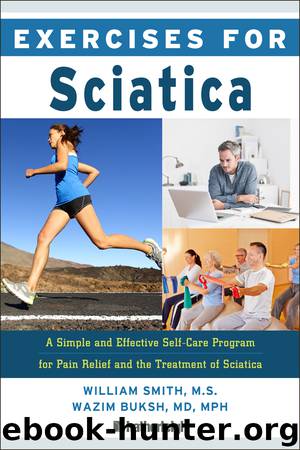Exercises for Sciatica by William Smith

Author:William Smith
Language: eng
Format: epub
Publisher: Hatherleigh Press
Published: 2020-01-20T16:00:00+00:00
WHAT TYPES OF EXERCISES BEST HELP WITH SCIATICA?
The exercises outlined in Chapter 5 have been carefully selected to improve mobility, increase flexibility, and strengthen muscles. These exercises target a range of symptoms, including but not limited to:
Hip pain
Lower back pain
Gluteal pain
Weakness or numbness
Keep in mind that as you begin any new exercise program, it is important to start slowly and pace yourself. As you get more comfortable over time, you can begin to increase the intensity of your workouts. Always pay attention to how your body is responding to an exercise routine and only increase frequency and intensity when your body is ready for it. Pay attention to your symptoms and take breaks if you need to do so, but above all do not give up. You have so much to gain from a well-planned exercise program, including increased energy, improved balance and mobility, and a better quality of life.
Sciatica exercises usually focus on three key areas: strengthening, stretching, and aerobic conditioning. These types of exercise may be done separately or in combination; examples of exercise that may include both strengthening and stretching include yoga, tai chi, and Pilates. And for anyone in chronic pain or with a relatively high level of sciatica pain, a good option for gentle exercise is water therapy, which is a controlled, progressive exercise program done in a warm pool.
Strengthening Exercises
There are many exercises which can help strengthen the spinal column and the supporting muscles, ligaments, and tendons. Most of these back-centric exercises focus not only on the lower back, but also the abdominal (stomach) muscles and gluteus (buttock) and hip muscles.
In addition to the back, building up strong core muscles can provide pain relief for sciatica sufferers by helping to support the spine, keeping it in alignment and facilitating movements that extend or twist the spine with less chance of injury or damage.
Stretching Exercises
Stretching is usually recommended to alleviate sciatic pain. Stretches for sciatica are designed to target those muscles that cause pain when they are tight and inflexible. For example, hamstring stretching is almost always an important part of a sciatica exercise program. Most people do not stretch these muscles (which extend from the pelvis to the knee in the back of the thigh) in their daily activities. Another stretch that is often helpful in easing sciatica is the Bird Dog, in which individuals get down on their hands and knees and extend one arm and the opposite leg, alternating between them.
When incorporating stretching exercises for the treatment of sciatic symptoms, another helpful technique is nerve flossing. Also called nerve gliding, these are gentle stretching exercises intended to stretch irritated nerves to reduce pain and improve range of motion. Gently flexing and extending one of your legs, while keeping your other muscles relaxed, is one example of nerve flossing.
Low-Impact Aerobic Exercise
Including some form of low-impact cardiovascular exercise, such as walking, swimming, or pool therapy, is common as a component of sciatic recovery. Aerobic activity encourages the exchange of fluids and nutrients in the
Download
This site does not store any files on its server. We only index and link to content provided by other sites. Please contact the content providers to delete copyright contents if any and email us, we'll remove relevant links or contents immediately.
Men In Love by Nancy Friday(5188)
Everything Happens for a Reason by Kate Bowler(4697)
The Immortal Life of Henrietta Lacks by Rebecca Skloot(4543)
Why We Sleep by Matthew Walker(4388)
The Sports Rules Book by Human Kinetics(4333)
Not a Diet Book by James Smith(3369)
The Emperor of All Maladies: A Biography of Cancer by Siddhartha Mukherjee(3110)
Sapiens and Homo Deus by Yuval Noah Harari(3023)
Day by Elie Wiesel(2743)
Angels in America by Tony Kushner(2621)
A Burst of Light by Audre Lorde(2566)
Endless Forms Most Beautiful by Sean B. Carroll(2439)
Hashimoto's Protocol by Izabella Wentz PharmD(2347)
Dirty Genes by Ben Lynch(2286)
Reservoir 13 by Jon McGregor(2263)
Wonder by R J Palacio(2178)
And the Band Played On by Randy Shilts(2159)
The Immune System Recovery Plan by Susan Blum(2038)
Stretching to Stay Young by Jessica Matthews(2009)
